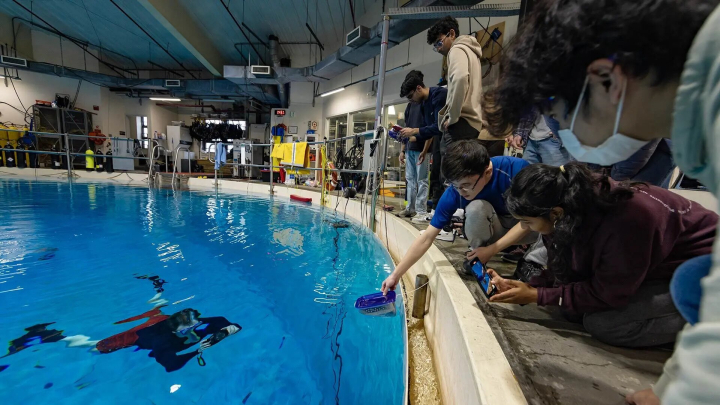Floating With Disaster
The fish was floundering. Bobbing precariously at the edge of University of Maryland’s neutral buoyancy tank, a robotic catfish struggled to swim as the students coaxed its motor. The device should have been cruising along the surface of the 367,000-gallon pool; but despite countless tests, hours and design reboots, something had gone very wrong.
That’s sort of the point, said Assistant Clinical Professor Lena Johnson ’14, M.S. ’16, Ph.D. ’22.
“The creative process is all about iteration; that’s how everything gets better,” she said. “But also, it’s going to fail. Sometimes that’s the goal. And everyone needs practice with that.”
The project, which challenged student teams to design and build a bio-inspired robot that could address an environmental challenge, such as sucking up microplastics from the Chesapeake Bay, is the students’ introduction into research at the University of Maryland, and a crash course in trial and error. Called Bio-Inspired Robotics, it’s the newest research group, or “stream,” offered through the University of Maryland’s First-Year Innovation & Research Experience (FIRE), an undergraduate program that immerses students in collaborative projects that accelerate career readiness and opportunity.
Building a robot from scratch is an exercise in creativity, logistics and careful planning—building one that works, as Johnson teaches her students, is about leveraging your failures. Surrounded by dog-eared pages of sketches and formulas, teams worked to hone their designs and “break them,” said Johnson. The gap between an idea and the physical manifestation can be yawning, as students discovered when testing early prototypes. Gears that grind. Waterproof casings that are anything but. Propellers that won’t propel.
In the months leading up to Tuesday’s big debut in the tank, students—mostly sophomores in majors ranging from business to computer science—worked feverishly in Johnson’s FIRE lab in the A.V. Williams Building, pivoting between laptops, a 3D printer and mock-up tank no bigger than a kiddie pool.
“We all learned the scientific method and the process of testing, but really only in theory,” said computer science major Neha Veeragandham ’26, whose team was attempting a water-filled bladder for its robot meant to regulate depth control, similar to a tuna. “So today, our stuff didn’t work and we have to redo everything. But that’s part of the process and something to take away.”
Click HERE to read the full article
The Department welcomes comments, suggestions and corrections. Send email to editor [-at-] cs [dot] umd [dot] edu.
